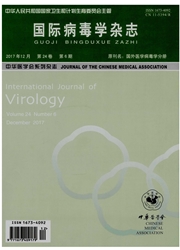

 中文摘要:
中文摘要:
目的调查深圳市某幼儿园发生的一起急性胃肠炎暴发疫情的病原体,并分析病原体的分子流行病学特征。方法收集患病幼儿及相关人员的粪便标本16份,剩余食物6份,采用国家卫生行业标准规定方法检测肠道致病菌、实时荧光RT-PCR法检测诺如病毒、札如病毒、轮状病毒核酸,逆转录RT-PCR法对病毒衣壳区和聚合酶区序列进行扩增,对PCR产物进行序列测定。序列用Clustalx软件进行多重比对、Mega5.0软件绘制系统进化树。结果16份样本中检出11例札如病毒核酸阳性,对其中3例阳性标本进行札如病毒衣壳区和聚合酶区序列测定,3株札如病毒与GII.3型参考株AY603425衣壳区核苷酸同源性为86.3%,聚合酶区核苷酸同源性为90.2%,3株札如病毒与GII.3型参考株AY603425、AB455793同属于GII.3型遗传分支。结论此起急性胃肠炎爆发是由GII.3型札如病毒导致,GII.3型引起的急性胃肠炎暴发属广东省首次报道。
 英文摘要:
英文摘要:
Objective To investigate and to analyze the molecular characteristics of the pathogen an acute gastroenteritis outbreak in a kindergarten in Shenzhen. Mehods Sixteen stool samples from diarrhea patients and the related people, six residua food were collected. National standards were used to detect pathogenic bacteria, real-time PCR was used to detect the RNA of noroviruses 、 sapovirusesrotaviruses. RT-PCR was used to amplify the capsid region and polymerase region of the viruses. Results Eleven samples from diarrhea patients were sapovirus-positive. Three positive samples were analyzed and sequenced, showing the homology of 86.3% and 90.2% in nucleotide sequences in Capsid and RdRp regions with reference strain AY603425. The phylogenetic analysis indicated that these three strains were in the same cluster with sapovirus reference strain AY603425 and AB455793, which belonged to GII.3 geneotype. Conclusions This outbreak of acute gastroenteritis was caused by GII.3 saroviruses,which was first reported in Guangdong province.
 同期刊论文项目
同期刊论文项目
 同项目期刊论文
同项目期刊论文
 期刊信息
期刊信息
